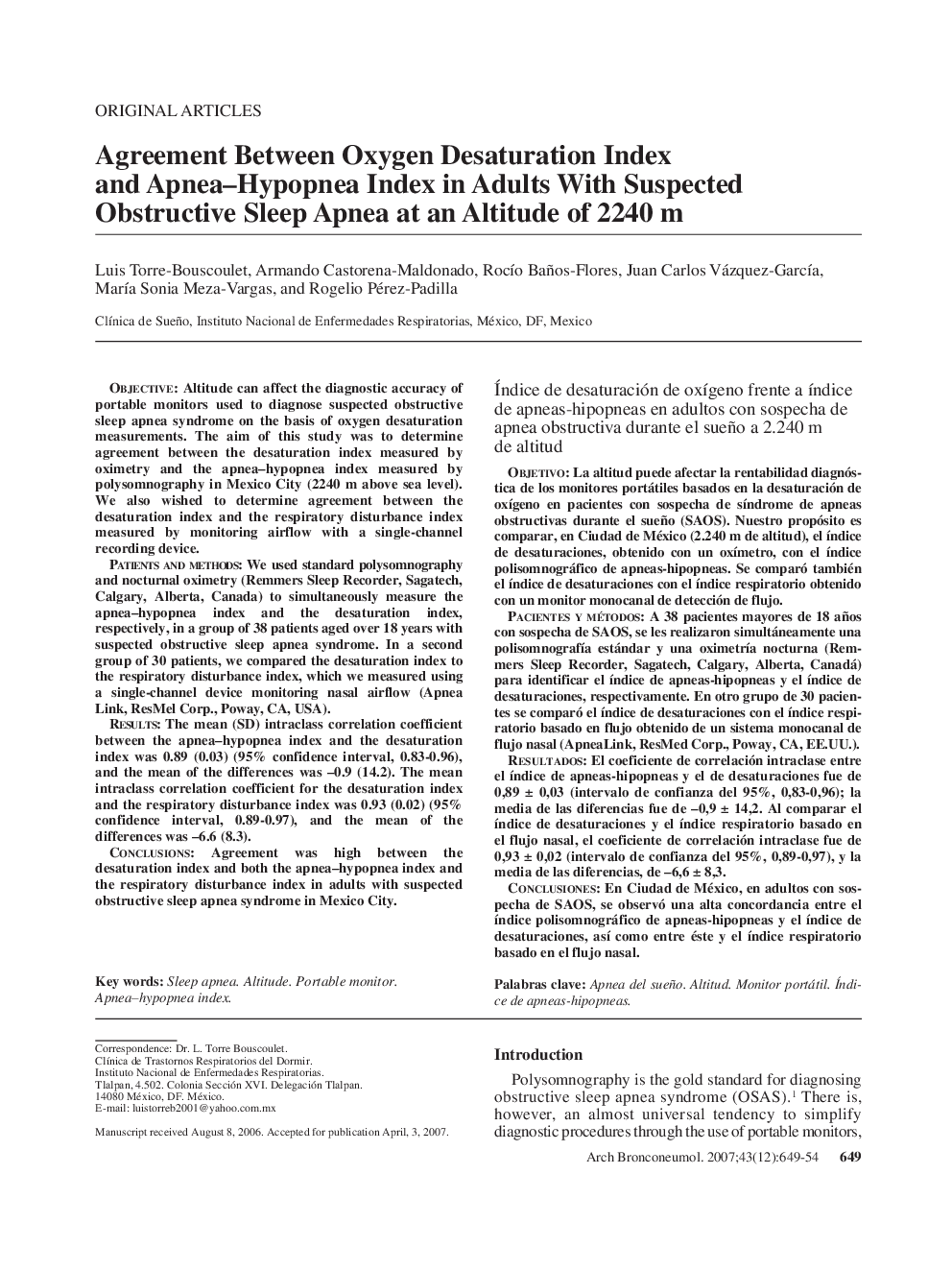| Article ID | Journal | Published Year | Pages | File Type |
|---|---|---|---|---|
| 4206865 | Archivos de Bronconeumología (English Edition) | 2007 | 6 Pages |
OBJECTIVEAltitude can affect the diagnostic accuracy of portable monitors used to diagnose suspected obstructive sleep apnea syndrome on the basis of oxygen desaturation measurements. The aim of this study was to determine agreement between the desaturation index measured by oximetry and the apnea-hypopnea index measured by polysomnography in Mexico City (2240 m above sea level). We also wished to determine agreement between the desaturation index and the respiratory disturbance index measured by monitoring airflow with a single-channel recording device.PATIENTS AND METHODSWe used standard polysomnography and nocturnal oximetry (Remmers Sleep Recorder, Sagatech, Calgary, Alberta, Canada) to simultaneously measure the apnea-hypopnea index and the desaturation index, respectively, in a group of 38 patients aged over 18 years with suspected obstructive sleep apnea syndrome. In a second group of 30 patients, we compared the desaturation index to the respiratory disturbance index, which we measured using a single-channel device monitoring nasal airflow (Apnea Link, ResMel Corp., Poway, CA, USA).RESULTSThe mean (SD) intraclass correlation coefficient between the apnea-hypopnea index and the desaturation index was 0.89 (0.03) (95% confidence interval, 0.83-0.96), and the mean of the differences was -0.9 (14.2). The mean intraclass correlation coefficient for the desaturation index and the respiratory disturbance index was 0.93 (0.02) (95% confidence interval, 0.89-0.97), and the mean of the differences was -6.6 (8.3).CONCLUSIONSAgreement was high between the desaturation index and both the apnea-hypopnea index and the respiratory disturbance index in adults with suspected obstructive sleep apnea syndrome in Mexico City.
OBJETIVOLa altitud puede afectar la rentabilidad diagnóstica de los monitores portátiles basados en la desaturación de oxígeno en pacientes con sospecha de síndrome de apneas obstructivas durante el sueño (SAOS). Nuestro propósito es comparar, en Ciudad de México (2.240 m de altitud), el índice de desaturaciones, obtenido con un oxímetro, con el índice polisomnográfico de apneas-hipopneas. Se comparó también el índice de desaturaciones con el índice respiratorio obtenido con un monitor monocanal de detección de flujo.PACIENTES Y MÉTODOSA 38 pacientes mayores de 18 años con sospecha de SAOS, se les realizaron simultáneamente una polisomnografía estándar y una oximetría nocturna (Rem-mers Sleep Recorder, Sagatech, Calgary, Alberta, Canadá) para identificar el índice de apneas-hipopneas y el índice de desaturaciones, respectivamente. En otro grupo de 30 pacien-tes se comparó el índice de desaturaciones con el índice respi-ratorio basado en flujo obtenido de un sistema monocanal de flujo nasal (ApneaLink, ResMed Corp., Poway, CA, EE. UU.).RESULTADOSEl coeficiente de correlación intraclase entre el índice de apneas-hipopneas y el de desaturaciones fue de 0,89 ± 0,03 (intervalo de confianza del 95%, 0,83-0,96); la media de las diferencias fue de -0,9 ± 14,2. Al comparar el índice de desaturaciones y el índice respiratorio basado en el flujo nasal, el coeficiente de correlación intraclase fue de 0,93 ± 0,02 (intervalo de confianza del 95%, 0,89-0,97), y la media de las diferencias, de -6,6 ± 8,3.CONCLUSIONESEn Ciudad de México, en adultos con sos-pecha de SAOS, se observó una alta concordancia entre el índice polisomnográfico de apneas-hipopneas y el índice de desaturaciones, así como entre éste y el índice respiratorio basado en el flujo nasal.
